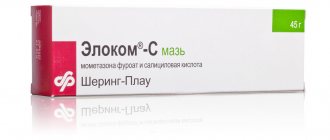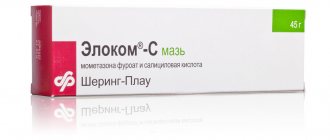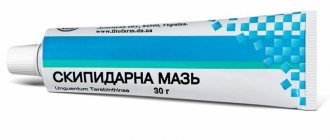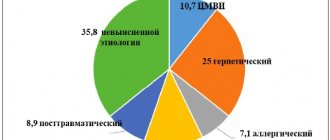Pharmacodynamics and pharmacokinetics
Pharmacodynamics
The active ingredient permethrin is a synthetic analogue of Dalmatian chamomile alkaloids, which has an insecticidal and acaricidal (anti-mite) effect. By disrupting the permeability of sodium channels, it affects the exchange in the membrane of nerve cells of parasites: fleas, lice, ticks (including demodex ), which leads to a paralyzing effect and their death. Having a small molecular size, the drug penetrates the hard cuticle of the tick and is concentrated in the hemolymph.
Pyrethroids are of low toxicity to humans because they do not accumulate in the body. They do not have nephro- and hepatotoxic effects and do not cause allergic reactions. For pediculosis, one treatment is sufficient and the anti-pediculosis effect lasts 2–6 weeks. Treatment of demodicosis is long-term.
Pharmacokinetics
It does not have a skin-resorptive effect; with cutaneous application, only 2% of the active substance is absorbed. A small amount of the drug that enters the systemic circulation is metabolized to pharmacologically inactive metabolites, which are excreted by the kidneys within 72 hours. Cumulation of the drug in tissues and organs does not occur.
Side effects
In some cases, there may be an irritating effect on the skin, a burning sensation, tingling or tingling, increased itching, swelling, numbness of the skin, paresthesia, pain, erythema, eczema, allergic reactions, including skin rashes, swelling. In such cases, the use of the ointment should be discontinued. In patients with scabies, itching may continue for 4 weeks after treatment. This may be due to an allergic reaction to dead scabies mites under the skin and does not indicate treatment failure.
Permethrin ointment, instructions for use (Method and dosage)
The ointment is intended for external use. It is recommended to apply a thin layer, rubbing until completely absorbed.
When treating scabies, apply only to the affected areas, once. After a day, you need to wash the treated areas with soap, change bed linen and clothes. They need to be washed and ironed. If new lesions appear, re-treatment with ointment is carried out after 2 weeks.
Permethrin ointment for demodicosis is used as part of complex therapy ( metronidazole , sulfur preparations , antibiotics Erythromycin or Clindamycin ). Apply to the affected areas once a day for a long time (a month), taking into account the life cycle of the Demodex mite. The procedure is performed in the evening, since tick activity is increased at this time. The drug is thoroughly rubbed in and is not washed off until the morning.
It is necessary to avoid contact of the drug with mucous membranes. In case of contact, they must be washed with water. After treatment, hands are thoroughly washed with soap.
Features of application
Pregnant
The drug is not recommended for use during pregnancy, unless the expected benefit to the mother outweighs the potential risk to the fetus and child. Breastfeeding should be stopped during treatment.
Children
Contraindicated for use in children under 2 months. For children over 2 months of age, use the drug as prescribed by a doctor.
Drivers
There are no reports on the effect of the drug on the ability to drive vehicles or operate machinery.
Analogs
Level 4 ATX code matches:
Medifox
Veda 2
Hygia
Spregal
Couple Plus
Pedilin
Nittifor
Benzyl benzoate , Sulfur ointment simple , Medifox , Spregal , A-Par .
Reviews of Permethrin ointment
Most reviews about this ointment are related to its use for demodicosis. Anyone who has encountered this problem knows how long and sometimes debilitating the treatment of this disease is. This is explained by the structural features of the mite cuticle, which has three layers. For this reason, large molecules of antiparasitic drugs cannot pass through the cuticle. The most effective remedy is an ointment based on permethrin, which has a minimal molecular size.
The effect of treatment is individual and depends on the extent of the process and the duration of the disease. This explains the mixed reviews. Everyone notes that the ointment is quickly absorbed, leaves no traces, is not noticeable on the face, and has a mild odor. Many people feel a tingling sensation at the site of application of the ointment ranging from moderate to intolerable:
- “... It helps me, it doesn’t dry out the skin, it relieves itching, the rashes have decreased”;
- “...I noticed only a short-term effect”;
- “...It works, but not very effectively”;
- “... 2 weeks after use, itching and flaking appeared.”
Some clinics have conducted studies on the use of this ointment for demodicosis. Their observations indicate that even in the first 2–4 days of treatment, no new rashes are observed, the inflammatory process subsides and regression of existing rashes begins. Clinical improvement was confirmed by laboratory testing (tick test), which showed the absence of mites in all patients after 2 weeks of treatment, however, taking into account the development cycle of mites, therapy was continued. Further observations of patients showed that the use of ointment helps prevent the development of relapses.
Permethrin-Pharma solution for external use 5mg/ml 60ml No.1
Name
Permethrin-pharma.
Release form
solution for external use
Dosage
5 mg / 1 ml 60 ml. Quantity per package - 1 pc.
Manufacturer
Pharmtechnology LLC.
INN
Permethrin.
FTG
A means of destroying ectoparasites.
Description
Transparent or slightly opalescent, yellowish or brownish-yellowish solution.
Compound
1 ml of solution contains 5 mg of permethrin as an active ingredient. Excipients: ethyl alcohol 96%, isopropyl alcohol, macrogolglycerol hydroxystearate, purified water.
Pharmacotherapeutic group
Products for the destruction of ectoparasites, including anti-scabies mites, insecticides and repellents. Means for the destruction of ectoparasites, including means against scabies mites. ATS code: P03AC04
Pharmacological properties
A remedy for the treatment of pediculosis. Destroys nits, larvae and mature individuals of head and pubic lice.
Indications for use
Treatment of diseases caused by the head louse pediculus humanus capitis.
Directions for use and dosage
Usually, a single use of Permethrin-Pharma solution is sufficient. To achieve the effect, the hair must be well soaked in the solution. The amount of solution needed for this depends on the hair: for short hair, about 25 ml is enough, long hair needs about 50 ml, very long and thick hair needs more (up to 150 ml in adults and children over 4 years old). Children. In children aged 2 months to 3 years, the maximum dose of the drug is 25 ml. Experience with permethrin is limited. Treatment should be carried out with caution under the supervision of medical personnel. Permethrin-Pharma is used only externally! The medicine should not be swallowed. Before using Permethrin-Pharma, the hair is washed with regular shampoo and towel dried. Slightly damp hair is evenly moistened with the solution using a cotton swab, especially rubbing the medicine into the roots of the hair. 30-45 minutes after treatment, the solution is washed off with warm running water, and the hair is combed with a fine comb to remove nits and dead lice. To ensure the full effect, hair is not allowed to be washed with shampoo during the first 3 days after using the drug, but rinsing with water is allowed. As a result, the drug remains on the hair and destroys nits and lice even after treatment. Control for re-infection should be carried out as often as possible, at least on the 5th day. The disease is easily transmitted from person to person, so it is recommended to examine all contacts in the family and in children's groups. When used correctly, the effectiveness of treatment is about 75% after a single application. However, to ensure a lasting effect and prevent re-infection, it is recommended to repeat the treatment after 8-10 days. After repeated use, the result is achieved at 95-100%. Preventive treatment with Permethrin-Pharma cannot prevent head lice infection. However, in an epidemic situation, simultaneous treatment of all members of the team (school class, kindergarten group) is often advisable, even in the absence of symptoms. It is recommended to simultaneously treat clothing and bedding of all people living together to avoid re-infection. Features of use in patients with impaired liver and kidney function. No data available. Features of the use of the drug in geriatric practice. In elderly patients, no dosage adjustment is required.
Side effect
The incidence of adverse reactions is listed as: rare (≥1/10,000 to
Contraindications
- hypersensitivity to permethrin or to any of the auxiliary components of the drug; - hypersensitivity to pyrethroids and pyrethrins; - children's age (up to 6 months). With caution: pregnancy.
Overdose
When applied topically, the active substance of the Permethrin-Pharma solution is poorly absorbed and therefore an overdose is unlikely. In young children, isopropyl alcohol poisoning is possible due to applying too much of the drug to the skin. In case of accidental ingestion of Permethrin-Pharma solution, the risk of poisoning is associated primarily with isopropyl alcohol and ethanol used as a solvent. In young children, due to the rapid absorption of these components, gastric lavage is necessary within the first hour, clinical monitoring for at least 3 hours or until symptoms of overdose disappear. In adults, gastric lavage should be performed within 1-2 hours. The use of an emetic or activated charcoal is not advisable. If symptoms of alcohol poisoning such as euphoria, ataxia, or worsening confusion are accompanied by low blood pressure, monitoring of electrolytes, osmolality, and blood sugar levels is required. In severe cases, hemodialysis is effective for rapid removal of isopropanol and ethanol. Forced diuresis is not effective. Nausea, headache, dizziness, and fatigue may occur as a result of ingesting permethrin. In severe cases, tingling, numbness, irritability and convulsions have been reported.
Interaction with other drugs
Permethrin-Pharma should be used undiluted. It should not be used simultaneously with surfactants, especially alkaline ones.
Precautionary measures
Treatment should only be carried out when lice eggs and/or live lice have been found. The treatment is carried out in a well-ventilated area or outdoors. It is necessary to avoid contact of Permethrin-Pharma with the mucous membranes of the eyes, nose, mouth, and external genitalia. If the substance gets on the mucous membranes, they must be washed with running water. Permethrin may worsen symptoms of asthma and eczema. Since the medicine contains 96% ethyl alcohol, ignition is possible. The occurrence of hypersensitivity reactions requires discontinuation of treatment with Permethrin-Pharma. Caution is required when using the drug in patients with allergies to chrysanthemums. In children from 6 months to 3 years of age, treatment should be carried out with caution and only under the supervision of medical personnel. After treatment with the drug, you should wash your hands with soap and rinse your mouth with running water.
Use during pregnancy and breastfeeding
Pregnancy Animal studies have not shown any reproductive toxicity. Clinical experience with use in pregnant women has not established the risk of fetal malformations/neonatal toxicity of permethrin. For safety reasons, use of the drug should be avoided during the first trimester of pregnancy. If necessary, permethrin can be used in the second and third trimester of pregnancy after careful assessment of the benefit/risk ratio. Lactation Studies of oral permethrin in cattle have shown that small amounts of permethrin are excreted in milk. Permethrin has been found in the milk of nursing women, who were most likely exposed to the substance through the skin, inhalation, or food.
Impact on the ability to drive a car and drive machinery
The drug does not affect the ability to drive a vehicle or operate potentially dangerous machinery.
Storage conditions
In a place protected from light at a temperature not exceeding 25°C. Keep out of the reach of children.
Best before date
2 years. The expiration date is indicated on the packaging. The medicine cannot be used after the date indicated on the package
Conditions for dispensing from pharmacies
The medicine is dispensed according to a doctor's prescription.
Package
60 ml in plastic bottles, placed together with the package insert in cardboard packs.
Buy Permethrin-Pharma solution d/nar. approx. 5 mg/ml in 60 ml bottle in pack No. 1 in the pharmacy
Price for Permethrin-Pharma solution d/nar. approx. 5 mg/ml in bottle 60 ml in pack No. 1
Instructions for use for Permethrin-Pharma solution d/nar. approx. 5 mg/ml in bottle 60 ml in pack No. 1
Permethrin ointment price, where to buy
It is not possible to buy Permethrin ointment in Russia, since it is not registered in Russia. You can purchase it in some online pharmacies, the cost of which ranges from 500 to 800 rubles.
The ointment has been registered in Ukraine, where you can purchase it at any pharmacy for 82-85 hryvnia.
- Online pharmacies in RussiaRussia
- Online pharmacies in UkraineUkraine
LuxPharma* special offer
- Permethrin ointment 40g, Latvia
RUB 1,780 order
show more
Pharmacy24
- Permethrin ointment 4% 40 g TOV LMP, Latvia
72 UAH order
Note!
Description of the drug Permethrin ointment 4% tube 40g on this page is a simplified author’s version of the apteka911 website, created on the basis of the instructions for use.
Before purchasing or using the drug, you should consult your doctor and read the manufacturer's original instructions (attached to each package of the drug). Information about the drug is provided for informational purposes only and should not be used as a guide to self-medication. Only a doctor can decide to prescribe the drug, as well as determine the dose and methods of its use.






